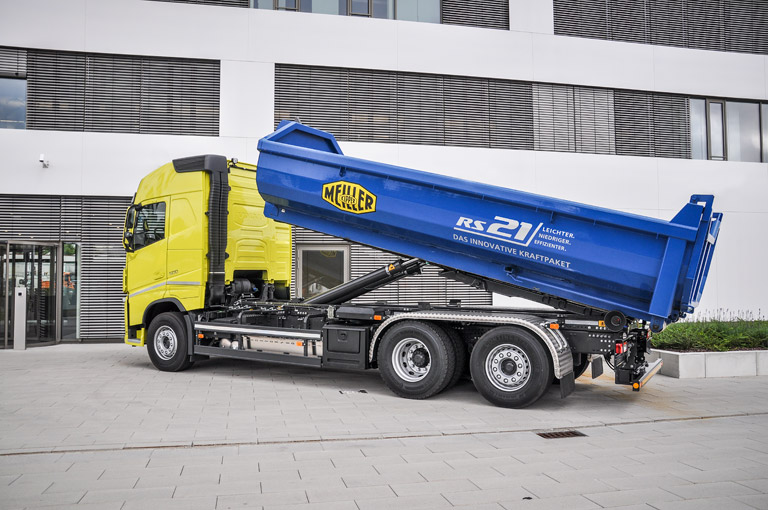Lighter, lower, more efficient
22.09.2016
The market-leader MEILLER has been causing a stir in construction and waste management logistics with its new hooklifts. The IFAT launch of the large RS21 is now followed by the RL18 at the IAA.

22.09.2016
The market-leader MEILLER has been causing a stir in construction and waste management logistics with its new hooklifts. The IFAT launch of the large RS21 is now followed by the RL18 at the IAA.

For many years, MEILLER has been serving its customers in construction and waste management logistics with modern hooklift systems, having established them as firm leader in both market and technology for over 20 years. This market segment is forever growing and requires ever more modern solutions, offering a more efficient operation. Like the new MEILLER RS21 hooklift equipped with an entire package of progressive and intelligent detailed solutions. The fastest in its class, it offers a larger payload and sets new safety standards.
The RS21, the number reflecting its 21 tonne lifting force, takes over from its model RK20 predecessor. Top marks in terms of tare weight, overall height and working speed are the results of all-round improvements. MEILLER Product Manager Michael Eicheldinger sums up the essential advantages: "Our new MEILLER RS 21 hooklift is lighter, lower and more efficient."
Highest torsion stiffness
In comparison to its predecessor, the weight has been reduced by up to 200 kg, adding to the available payload and improving fuel consumption. The RS21 has been consistently lowered - as opposed to tuning cars, however, this is done with economic benefits in mind. It enables taller containers to be loaded, without exceeding legal limits, an advantage in terms of restricted clearance heights and when it comes to high-volume transport. At the same time the height of the vehicle's point of gravity is reduced, improving driving characteristics and benefiting driving safety. The new frame with closed profiles is unique among the competition; it offers extremely high torsion stiffness and is mounted weld-free with bolt technology, which means it does not affect the original vehicle manufacturer's serial corrosion protection.
A special argument in favour of the new MEILLER RS21 is its working speed. In certain work sequences, it has doubled, making the RS21 the fastest among the competition, when looking at the entire working cycle. The new high speed valve means containers can not only be lifted more quickly, but they will also be lowered more quickly, once the tipping process has been completed. The system is always in operation, is fully automated and works load-dependent, thus preventing any kind of operating errors. In order to protect the vehicle, the containers are positioned with a hydraulic limit stop damping. The rear under-ride guard is also positioned hydraulically. Its scissors-like extension and retraction makes it insensitive to dirt or damage.
The little brother: RL18
The new hooklift RL18, which MEILLER presents at the IAA, is another 100 kilograms lighter and another 40 mm lower in overall height than the RS21. The RL18 with its 18 tonne lifting force has been designed for high-volume and payload-optimised transportation. At the MEILLER stand it is shown without a chassis, but fully functioning, which means it can be inspected in fine detail from up close. As the RS21, the RL18 also uses the enclosed frame profile and the efficiency packet, consisting of the hydraulic limit stop damping, high speed operation and fast motion. The safety package, consisting of hydraulic container lock, hydraulic under-ride guard and electronic servo control, is also the same.
More operational liability with servo controls
The signal yellow MEILLER i.s.a.r remote control, is already firmly established among the users of MEILLER skip handlers and hooklift. The i.s.a.r. control enables the operator to control all superstructure functions from within a radius of up to 30 metres around the vehicle at the push of a button. All required functions are integrated, and the control includes a prominent Stop-Start button in the centre for the vehicle engine. Even brief phases without the engine running save fuel and reduce noise and pollution emissions – not to mention the costs involved. Networked electronics not only improve operating ease, the optional servo controls reduce the number of operating steps, saving time and practically ruling out operating errors. In order to prevent errors, the electronic remote control unit is located in a fixed charging cradle installation in the driver’s cab, while the on-board electrical system supplies the rechargeable batteries with power. To improve night-time operation and work in diffused light, the keypad is illuminated.